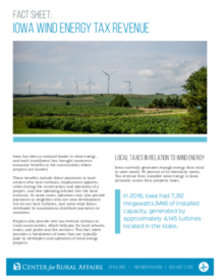These benefits include direct payments to landowners who host turbines, employment opportunities during the construction and operation of a project, and new spending infused into the local economy. In some cases, operators may also provide payments to neighbors who are near development but do not host turbines, and some wind farms developed by associations distribute payments to members.
Projects also provide new tax revenue streams to rural communities, which help pay for local schools, roads, and police and fire services. This fact sheet provides a breakdown of taxes that are typically paid by developers and operators of wind energy projects.
Local taxes in relation to wind energy
Iowa currently generates enough energy from wind to meet nearly 40 percent of its electricity needs. Tax revenue from installed wind energy in Iowa primarily comes from property taxes.
Property tax
Property taxes on wind energy conversion property are assessed and collected by the counties where projects are located.
In Iowa, counties may create ordinances for special valuation of a wind energy system.
- This special valuation is assessed based on the net acquisition cost.
- Property is assessed at a rate of 0 percent of the net acquisition cost in the first year after installation. The rate increases by 5 percent each following year before it is capped at 30 percent in year seven.
A 2014 study by the Iowa Department of Revenue provided an estimate of the new revenue that was generated by wind energy systems, specifically those that were awarded credits from the state’s Wind Energy Production and Renewable Energy Tax Credit program.
- For projects participating in the tax credit program, the total net acquisition cost used to determine the special assessment rate in 2006 was $58.9 million. By 2013, the total cost was estimated to be at $55.7 million.
- The report estimates that in 2009, existing participating projects with a special assessment generated $80,000 for local counties and cities. These amounts were projected to increase to $958,000 in 2015, and $1.8 million in 2021.


